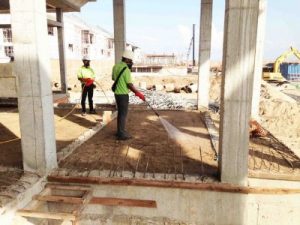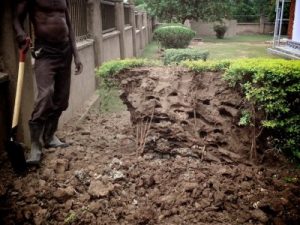
No need to explain that preventing the subterranean termites from entering your house is always better then fighting an infestation afterwards.
If you’re building a new house – you have a perfect opportunity to build in the anti-termite barriers before the construction or during it.
Hide content
- How does it work?
- Chemical barrier
- Physical barrier
- Physical barrier impregnated with termiticide
- Useful articles
- Helpful video
- Conclusion
For the pre-construction treatments, you have three choices:
- Chemical soil barrier.
- Physical barrier.
- Physical barrier impregnated with chemical termiticide.
Learn more about subterranean termites: signs of their activity; best methods of treatment and DIY methods. Eastern subterranean termites and their tunnels and tubes with photo.
How does it work?
The barriers, chemical or physical, that are installed during the construction, help you to prevent the subterranean termites finding the unsecured points to enter your house.
Nesting in the soil, this termite colony sends its foragers to search for food in every direction.
If your house is unprotected, it has many weak points that termites can use. Some of the termites are known to be able to go through the concrete to reach their aim, all they need is a tiny crevice.If you have any wood in contact with the soil, then you’re simply inviting the pests to come in.
There is one difference that makes subterranean termites more of a pain for the house owners than the drywood ones – their nesting habits. The drywood termites live the same place they eat, so once you noticed the infestation, you can get rid of them for good, treating only the wood they are nesting in.
Efficient extermination of the subterranean termite includes the destruction of the colony, location of which is unknown. This is why pre-construction protection against those pests is a very good idea.
Here you can learn more information about effective termite control remedies: Bora-Care, Boric acid, Borate, Fipronil, Chlorpyrifos, Chlordane, Borax, Timbor, Termidor, Terminator, Phantom, Lorsban, Biflex, Terro. You can choose different forms, such as – foam, liquid, powder.
Chemical barrier
Soil treatment can be performed also after the house construction, but then you face some difficulties. It’s hard to make the barrier solid, when you have all the obstacles, like driveway, to go around.
Post-construction soil treatment might include some concrete drilling or cutting, and even after that you cannot guarantee you haven’t left a tiny gap for the termites to enter.
Another thing is the pre-construction barrier. You will need no drillings to make sure that the line of defense is impenetrable.
In short, this is what you going to do:
- Mix the termiticide with water according to the label instructions.
- Dig the trench around the future foundation, abut 6-12 inches wide and 6 inches’ deep.
- Using the bucket or a watering can, pour the insecticide dilution into the trench (about 4 gallons per 10 linear feet).
- Mix the soil, that has been removed with more termiticide and refill the trench with it.
This sounds rather easy, but you should pay attention to the process – inch of untreated soil will give the termites a chance.
You also should remember that the type of soil itself matters. The ground should be able to absorb and keep the dilution poured on it.
So, if you have mostly clayish soil, you might need to replace it, to make the treatment efficient.
Another thing that can make the soil not good for the treatment is its oversaturation, for example with rain water. If the ground has already absorbed too much water, it will not keep the termiticide and the chemicals will be washed away it easily. Choose the time of the year when this is unlikely to happen.
Important! If the barrier goes through the bed where you grow vegetables for food – don’t eat the crops for at least one year.The choice of termiticide will largely depend on you choosing to perform the treatment yourself or trusting it to professionals. Most of the strongest chemicals for the soil barrier placement require a special license, that only professional pest operators will have.
This is done to minimize the risk of the chemicals damaging the environment. Many of the termiticides are harmful to the bees, fish or other animals and have to be applied with great precaution.
Usually, depending on the chemical specifics, the protection of the soil barrier lasts from 5 to 10 years, and after that you will need to renew it.
The pest operators might recommend you to combine the chemical barrier with the wood treatment, especially of the timber that comes in contact with soil. This way you’ll create the protection that will be almost impenetrable for termites.
Here you can learn more information about termite bait systems: Advance, Green, CSIRO, Nemesis, Exterra, Firstline, Terminate. Also find out how to make baits by yourself and how to refill them?
Physical barrier
As the name says, this type of barriers prevents the termites to physically penetrate it. Basically it’s a layer of a material, that cannot be pierced by termites. There’re absolutely eco-friendly and environmental responsible variants of this measure:
- sand barrier;
- basalt barrier;
- steel mesh barrier.
Sand and basalt barriers have the same basic principal. It consists of small particles, where the biggest ones will be too big for termites to move, and smallest will fill the gaps between, not letting the insects to squeeze between.
The layer of material is added around the foundation, slabs and piers of the construction. This barrier type has its drawbacks: If the material is somehow contaminated with dirt, weed roots or soil, the protection is weakened.
Steel mesh barrier is pretty much a metal grid with tiny holes, that are not big enough for termites to enter. The weeds will not grow through metal, and it won’t be washed away by rains.Here you can learn more information about effective treatment method called tenting (fumigation): dangers for termites, preparing for fumigation and cleaning after, how long does this procedure last?
Physical barrier impregnated with termiticide
If you’re looking for something that will give a combined protection of those two treatments, you are looking for the physical barrier that will have a built in repellent termiticide. Luckily, they exist.
Several manufacturers produce a specific polymer, that has a strong repellent termiticide incorporated in the structure of the material itself. The chemicals repel the pests and kill the ones that have a courage to take a bite. This kind of barrier systems are very popular in Australia, the country that suffers greatly from constant termite invasions.
As the material is more flexible then the steel mesh, the technique of its placement is a bit different from other physical barriers. The installation has to be done by the professional builders, licensed for the use of those barriers.
Essentially, they will simply wrap all the construction elements, that are nesting beneath the soil, in the polymer sheets. There’re plastic sheets of different shapes and thickness, that are made for specific construction elements.
One of the many plusses of this chemical protection is that, while the termiticide is impregnating the polymer, even the strong chemical is strongly bond with the material and won’t be carried away into the environment.
Also it means that the workers installing it don’t need any special skin or eye protection.
The manufacturing companies that produce this kind of termite protection are so sure in the quality of their product, that they usually offer a huge warranty for very long period of time.
Generally, this kind of barrier should prevent the subterranean termites from entering your property for minimum 25 years, which is normally the warranted time. But the protection might last for as long as 50 years.
Important! Of course, there’re special conditions for being subjected to the warranty, such as annual inspection by the pest control authorities.Useful articles
If you interested in more information of termites we recommend you to read the following articles:
- All types of termites. Are they harmful to humans? Can they bite you? And what is the difference between drywood and subterranean ones?
- What does swarmers of different species look like: drywood, subterranean, formosan?
- Signs of infestation outside and in the house: in walls or furniture.
- How to treat them at home and in the yard: in wood or in fence. How long this process lasts and what is soil treatment?
- What does termite holes look like? What is droppings and is it toxic to humans? Do termites make noises?
- Posible termite damage, how does it look like? Examples of damage in walls and wood floors.
- All about flying termites: how do they look like, swarming season and what to do if there are swarmers in your house?
- How do they do nests and mounds? How to find it in your garden or inside the house?
- Termite life cycle – from egg to larvae. And social hierarchy: workers, soldiers, queen.
- Did you know that termites can infest living trees, for example a palm or a pine tree. They also like to live in stumps.
- You can prevent the infestation by using barriers, such as: HomeGuard, Physical systems, Safeguard, Stainless steel mesh, Kordon.
- If you want to get rid of termites naturally, learn more about such methods as: heat or cold treatment, orange oil, using nematodes.
Helpful video
Pre-construction termite treatment with liquid termiticide:
Conclusion
Whatever pre-construction treatment you’ll choose – this is a smart decision. Even the most expensive barriers will cost you less than all the repairs and treatments you’ll have to do in case the infestation will happen. And if you can protect your dream home for the long years to come, why not to invest a bit in it.

